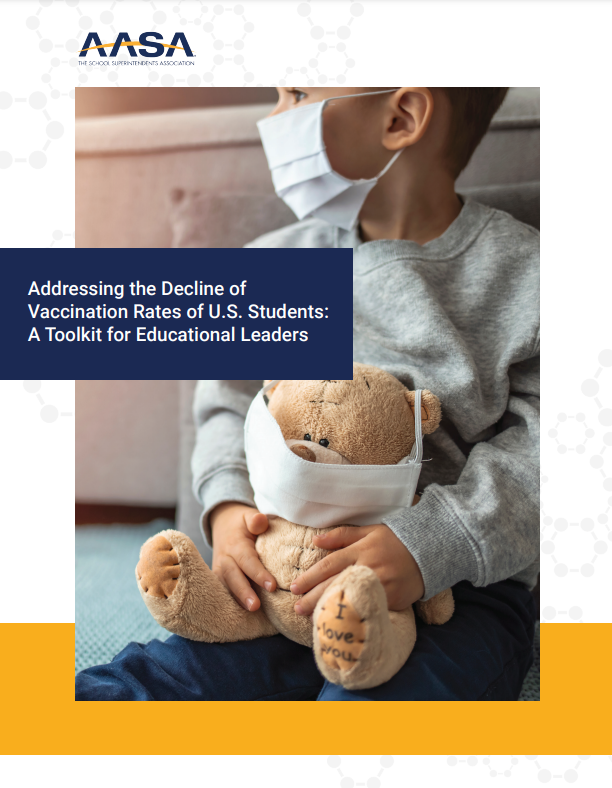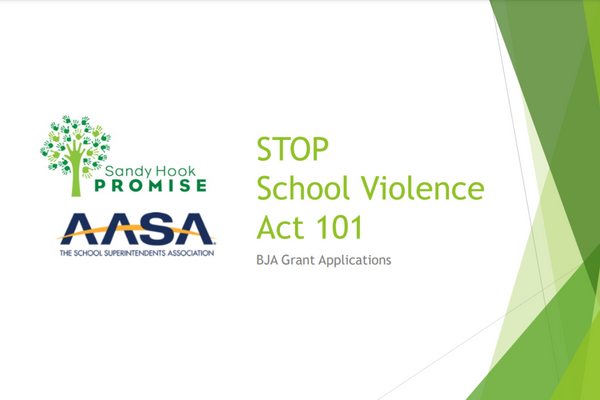Addressing the Decline of Vaccination Rates of U.S. Students
May 01, 2022

A Toolkit for Educational Leaders
To address the issue of declining student vaccination rates resulting from the COVID-19 pandemic, AASA has partnered with the Merck Foundation (MSD Inventing for Life) to support the development and distribution of a comprehensive toolkit for educational leaders.
This toolkit provides resources to support educational leaders in understanding and providing direction about how schools and districts can address the problem of vaccination declines among students.
Introduction
Data suggest that the percentage of children receiving required vaccinations (i.e., the seven-vaccine regimen required for entrance to public education) has decreased by 14% during the pandemic and related school closures. According to the American Academy of Pediatrics, “During the COVID-19 pandemic, children have missed routine well-child care and related vaccinations.
If [these] rates decline below levels to maintain herd immunity, dangerous outbreaks of preventable diseases could follow.” This toolkit is available to superintendents, school boards, executive staff, school-based administration and teachers, as well as families and community members. A major priority of this is to ensure that superintendents and other district leaders have the knowledge, skills, and resources to address this challenging national health issue.
Key principles underlying this initiative include:
- Ensuring maximum distribution of the toolkit;
- Promoting cross-institutional partnerships and communities of practice (including school districts, schools, state and local governments, health agencies, and community advocacy groups) to implement toolkit-related recommendations and strategies;
- Disseminating vaccination rate updates and data; and
- Sustaining the work beyond the one-year grant-funding cycle to ensure growing levels of vaccination rates within communities and regions (especially those most severely impacted by scarcity of access to available health services).
The Urgent Need for Catching Up—Understanding the Implications of Declines in Childhood Vaccination Rates Resulting from the COVID-19 Pandemic
This first module sets the tone and focus of the entire toolkit, reinforcing the urgent need to ensure that all students receive required vaccinations. It also sets the stage for vaccinations to be seen by educators and the public as an essential issue of equity. Module One addresses the impact of the pandemic upon students’ health, psychological development, academic performance, and attendance. It also includes an exploration of the long-range implications of the pandemic and related vaccination declines upon future academic growth and social-emotional well-being of members of the learning organization.
Essential Questions
- What has been the impact of the COVID-19 pandemic upon students’ required vaccinations?
- Why is it essential for educational leaders to support their districts and schools in addressing this issue?
- What are the health, well-being, and long-term academic implications of dramatically lowered vaccination rates?
- What is the impact of lowered vaccination rates on student health, well-being, and academic achievement?
- What have been the short- and long-range effects of this decline on family and community health?
- To what extent is the issue of lowered vaccination rates an equity concern?
Outcomes
Analyze the critical importance of student vaccinations and their impact on student well-being, health, development, and academic achievement.
Identify short- and long-term implications of student vaccination declines resulting from the COVID-19 pandemic.
Investigate the implications for educational leaders helping to address the issue of vaccination declines among American students.
Explore the extent to which declining vaccination rates constitute an equity issue in American education today.
Strategies for District and School Leaders to Increase Staff Understanding of Lowered Vaccination Rates and Their Impact on the Learning Organization
It is essential that all staff members understand the significance of declining vaccination rates upon student growth and development, health and well-being, and academic progress. This priority is an essential one for district and school leaders, especially in light of the emergence of this unanticipated issue resulting from the COVID-19 pandemic and related school closures. Therefore, this module will concentrate upon a range of ideas for professional engagement and learning, including ideas for workshops, study groups, action research, and communities of practice working on identified problems related to lowered vaccination rates.
Essential Questions
- What can district and school leaders do to increase staff understanding of the implications of lowered vaccination rates?
- What do staff members need to know, be able to do, and understand about the implications of lowered vaccination rates upon student health, well-being, and academic performance?
- What are the implications of the issues raised here for professional learning?
Outcomes
Identify key priorities for staff understanding of the relationship between vaccination declines and their potential impact upon student growth and achievement.
Explain focus areas related to what all staff should know, be able to do, and understand about their potential role in addressing the issue of lowered vaccination rates
Describe key professional development strategies and processes proven effective in addressing emerging problems of practice, including interactive information sessions, study groups, action research teams, and professional learning communities.
Addressing the Needs of Parents and Families: How Can Leaders Engage Them in Addressing Lowered Vaccination Rates?
This module will focus upon parents and families in general (i.e., the universal implications of lowered vaccination rates), emphasizing the critical importance of educational leaders engaging in outreach and information dissemination about declining vaccination rates among children. It is essential that parents and families are well informed about this crisis—and that they understand the services and resources available to them. The module will also explore the implications of declining vaccinations as an equity issue severely impacting certain demographic and economic groups in urban and rural areas where access to medical care and facilities may be a major impediment to ensuring student health and well-being
Essential Questions
- What are the implications of lowered vaccination rates for parents and families?
- What are the causes of resistance and non-compliance among parents involving required vaccinations for their children?
- How can leaders engage parents and families in the discussion and understanding of the need to increase vaccination rates in public schools?
- To what extent are declining vaccination rates an equity issue that most severely impacts families in urban and rural populations?
Outcomes
Explain the major reasons for vaccine hesitancy and non-compliance among parents and families.
Analyze the implications of lowered vaccination rates for parents, families, and communities.
Investigate engagement strategies to provide information and support for parents and families to improve declining vaccination rates.
Assess the equity implications of declining child vaccination rates, especially among urban and rural populations.
Building Cross-Institutional Partnerships to Develop and Sustain School & District-Level Vaccination Clinics
This module showcases the importance of building effective community partnerships as an essential component of addressing declining student vaccination rates. It emphasizes the major implications of such partnerships for addressing problems of practice in general—and the critical need for community representation in efforts to increase vaccination rates. The module emphasizes the power and significance of Communities of Practice as collaborative structures to identify and address significant problems of practice facing schools, districts, and regions. A major focus of this module is the critical importance of streamlining student and family access to vaccination clinics, including examples of state and district efforts to create school-based and community-centered vaccination and health service clinics.
Essential Questions
- Why is it essential for community members to become actively involved in increasing vaccination rates among school children?
- How can educational leaders successfully engage community partners in understanding the importance of this effort and the power of localization of student health services (e.g., school-based clinics)?
- How can districts and schools establish partnerships with community organizations to form Communities of Practice to ensure equitable student and family access to vaccinations and related health services?
Outcomes
Analyze the key components of an effective school-based vaccination clinic as it evolves from initial design and implementation to sustainability
Explain the significance of community understanding and involvement in addressing the issue of declining student vaccination rates extending from the COVID-19 pandemic and the role of community partners in school-based vaccination clinics.
Identify key strategies and processes that educational leaders can use to engage community partners in addressing the issue of declining student vaccination rates and the development of one or more school-based vaccination clinics.
Form “Communities of Practice” to reinforce community support and engagement in increasing student vaccination rates.
Investigate the use of federal recovery funding sources to create and sustain school-based and/or community health clinics and vaccination sites.
Communication and Engagement Strategies: Promoting Community and District Support in Increasing and Sustaining Student Vaccination Rates
This module extends and refines ideas and strategies presented in previous models related to community and district outreach and support. It provides a detailed set of recommendations concerning communication priorities and strategies as a district moves through the inevitable stages of change associated with developing and sustaining school-level vaccination clinic initiatives. The module organizes these ideas around four key phases: (a) Initial Program Design and Preliminary District and Community Outreach; (b) Development of Initial District- and School-Level Vaccination Clinics; (c) Scaling Up and Expanding Vaccination Initiatives and Programs; and (d) Ensuring Sustainability and Anticipating Future Vaccination Priorities and Needs.
Essential Questions
- During the initial phases of program design, what should superintendents and other district leaders do to engage district and community support for student vaccination initiatives?
- What kinds of outreach and communication processes are necessary to ensure the success of initial district- or school-level vaccination clinics?
- How do successful districts scale-up and expand their efforts to maximize student vaccination rates?
- How can district leaders and staff ensure sustainability of student vaccination efforts in their learning organizations?
Outcomes
Identify key outreach and communication strategies used by effective superintendents and other district leaders to engage district and community involvement in student vaccination initiatives.
Investigate key requirements for initial district- and school-level vaccination clinics, including options for partnerships with health agencies, physicians, and community organizations.
Analyze non-negotiable elements for successful scaling up/expansion of student vaccination initiatives in schools and districts.
Explore strategies for sustaining student vaccination efforts, including structural components for anticipating future health emergencies and pandemics.
From Getting Started to Sustaining the Journey: A Comprehensive Planning Guide for Ensuring Vaccination Equity & Student/Family Access to Vaccination-Related Health Services
This module provides a comprehensive planning guide for superintendents and other district leaders committed to ensuring vaccination equity. It provides suggestions and a planning grid for the four key phases of vaccination clinic development: (a) Initial Program Design and Staff/Family/Community Outreach; (b) Development of District- and/or School-Level Vaccination Clinics; (c) Scaling Up and Expanding Vaccination Initiatives and Programs; and (d) Ensuring Sustainability and Anticipating Future Vaccination-Related Priorities and Needs. The planning matrix includes performance indicators for each of the four phases of program implementation as well as space for indicating artifacts and deliverables, individuals responsible for leading each phase, data collection and evaluation of outcomes, and a timeline for each key component.
Essential Questions
- What are the key components associated with each phase of developing district- and school-level vaccination clinics?
- What should district leaders consider during initial stages of program design and outreach?
- How can educational leaders ensure that initial vaccination clinics are well designed and sufficiently resourced to meet the needs of students and families?
- What do successful leaders do to scale up and expand initial vaccination initiatives and programs?
- How can educational leaders use data and related information to anticipate future potential vaccination-related priorities and needs in their district?
Outcomes
Identify four key phases of vaccination clinic program development.
Ensure that all required components are in place during initial implementation of district- and/or school-level vaccination clinics.
Analyze requirements for scaling up and expanding initial vaccination clinics to ensure that all students and families within a district are served.
Use data and related information to predict potential vaccination-related issues and needs in a specific learning organization.
Advertisement
Advertisement
Advertisement
Advertisement

.png?sfvrsn=ffae7191_7)

